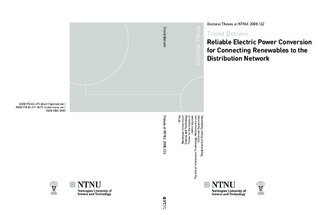| dc.contributor.author | Østrem, Trond | nb_NO |
| dc.date.accessioned | 2014-12-19T11:20:02Z | |
| dc.date.available | 2014-12-19T11:20:02Z | |
| dc.date.created | 2008-05-08 | nb_NO |
| dc.date.issued | 2008 | nb_NO |
| dc.identifier | 124343 | nb_NO |
| dc.identifier.isbn | 978-82-471-8477-6 | nb_NO |
| dc.identifier.uri | http://hdl.handle.net/11250/227949 | |
| dc.description.abstract | When connecting distributed power generation systems to the utility grid, a power converter is normally placed between the main grid and the local micro-grid, at the point of common coupling. In order to synchronize the converter to the utility grid voltages, a synchronizing circuit is needed. A common way of doing this, is to use a phase-locked loop (PLL). This circuit estimates a voltage reference angle which is fed to the control system of the power converter. One of the simplest PLL designs is based on the grid voltage zero crossings. The drawback of this method is that no information about the grid voltage conditions is available in the interval between the zero crossing. The design has been implemented and successfully tested on a Field Programmable Gate Array (FPGA) circuit connected to a power converter.
A more advanced way of designing a PLL is by using voltage vector control. The method is more complex and time consuming. On the other hand, information about the grid voltage condition is always available. The design fails to run properly if the grid voltages are unbalanced or distorted. In order to improve the performance, a multi-variable filter tuned at nominal grid frequency may be added. This solution has been implemented on an FPGA circuit and successfully tested.
The multi-variable filter will cause an angle displacement if the grid frequency deviates from its nominal value. The author proposes a method called Adaptive Signal Cancellation (ASC), in order to make the PLL frequency independent. The method is based on a method called Delayed Signal Cancellation (DSC) where the grid voltages are inputted and symmetric voltage components are outputted. Instead of delaying signals, the ASC is phase shifting signals, obtaining approximately the same performance. In addition to providing the control circuit with an estimated voltage reference angle, the circuit also outputs signals determining grid voltage conditions: voltage level, symmetry and frequency. These signals can be used in an overhead control structure taking care of power management and protection. | nb_NO |
| dc.language | eng | nb_NO |
| dc.publisher | Fakultet for informasjonsteknologi, matematikk og elektroteknikk | nb_NO |
| dc.relation.ispartofseries | Doktoravhandlinger ved NTNU, 1503-8181; 2008:122 | nb_NO |
| dc.title | Reliable electric power conversion for connecting renewables to the distribution network | nb_NO |
| dc.type | Doctoral thesis | nb_NO |
| dc.contributor.department | Norges teknisk-naturvitenskapelige universitet | nb_NO |
